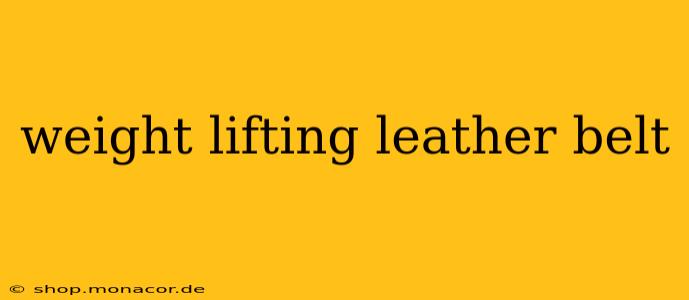Weightlifting, whether you're a seasoned powerlifter or a beginner, demands strength, technique, and—crucially—support. A high-quality weightlifting leather belt is a vital piece of equipment that can significantly enhance your performance, protect your lower back, and help you lift heavier weights safely. This comprehensive guide explores everything you need to know about choosing and using a weight lifting leather belt.
What are the benefits of using a weight lifting leather belt?
A weightlifting leather belt offers several key benefits:
-
Increased Intra-abdominal Pressure (IAP): This is arguably the most significant advantage. By tightening the belt, you create a rigid structure around your core, increasing IAP. This stabilizes your spine, reducing the shear forces on your lower back during heavy lifts. Think of it as a natural corset, providing crucial support.
-
Improved Core Stability: The increased IAP translates directly to enhanced core stability. This allows you to maintain proper form throughout your lifts, preventing injury and maximizing your lifting potential.
-
Enhanced Lifting Capacity: With a more stable core and reduced risk of injury, you'll be able to lift heavier weights with confidence, contributing to faster strength gains.
-
Reduced Risk of Injury: By supporting your lower back and stabilizing your spine, a weightlifting belt significantly lowers the risk of lower back injuries, hernias, and other related problems. This is especially important during heavy compound lifts like squats, deadlifts, and bench presses.
-
Improved Lifting Technique: The support provided by the belt encourages proper form. You'll be less likely to compensate for weak points by compromising your technique, leading to safer and more effective workouts.
What types of weightlifting leather belts are there?
Leather weightlifting belts come in various styles, each with its own pros and cons:
-
10mm-13mm Thick Belts: These are the standard for serious powerlifters. They provide maximum support and rigidity. They're usually suitable for the heaviest lifts.
-
Powerlifting Belts (Lever Belt): These feature a lever buckle system, providing a secure and quick fastening mechanism. They're very popular because of their ease of use.
-
Weightlifting Belts (Double Prong Buckle): These are often slightly more flexible than lever belts and use a double prong buckle. Some lifters find these more comfortable for longer workouts.
What size weightlifting leather belt should I choose?
Selecting the correct size is critical for optimal performance and comfort. Most manufacturers provide detailed sizing charts based on waist measurement. Measure your waist at the natural waistline—where you typically wear your pants—and consult the manufacturer's chart to determine your correct size. A belt that's too loose won't provide adequate support, and one that's too tight will be uncomfortable and restrict your breathing.
How tight should I wear my weightlifting leather belt?
This is a frequently asked question, and the answer is nuanced. You should tighten the belt enough to feel secure support without compromising your breathing or causing discomfort. Many lifters use the "one breath" test; if you can take a full, deep breath without straining, you've likely found the right tightness. It's common to loosen the belt slightly between sets.
When should I use a weightlifting leather belt?
While a weightlifting belt is beneficial, it's generally recommended to use it primarily for your heaviest sets of compound exercises. For lighter sets or accessory exercises, you might choose not to wear it. This helps prevent you from becoming overly reliant on the belt and maintains the development of your core musculature.
Is a weightlifting belt necessary for all lifters?
While highly recommended, a weightlifting belt isn't strictly necessary for all lifters, particularly beginners. Focus on building proper lifting technique and core strength first. However, as you progress and start lifting heavier weights, a quality leather belt becomes increasingly important for safety and performance.
How do I care for my weightlifting leather belt?
Proper care extends the life of your leather weightlifting belt. After each use, wipe it down with a damp cloth to remove sweat and dirt. Avoid getting it excessively wet, and allow it to air dry naturally. Occasionally, you can condition the leather with a leather conditioner to maintain its suppleness and durability.
This guide provides a comprehensive overview of weightlifting leather belts. Choosing the right belt, learning to use it correctly, and taking proper care will significantly enhance your weightlifting journey, improving both safety and performance. Remember always to prioritize proper technique and listen to your body.

